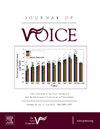带音中元音修饰策略的声学理论
IF 2.4
4区 医学
Q1 AUDIOLOGY & SPEECH-LANGUAGE PATHOLOGY
引用次数: 0
摘要
许多作者都认为,“带音”是由“像说话一样”的声音发出的,第一和第二声道上共振(fR1和fR2)的元音频率由要唱的歌词决定。在声学上,带状带的标志已被确定为主要的二次谐波,可能通过第一共振调谐(fR1≈2fo)增强。目前还不清楚这两个概念是如何——(a)用“像讲话一样”的未修饰元音发音;(b)在歌手的整个音高范围内唱歌时,产生一种带音的主音二谐波,通常由fR1增强。例如,来自教师的轶事报告表明,fR1较低的元音,如[i]或[u],可能必须进行相当大的修改(通过提高fR1)才能发出更高的音调。这些问题被系统地解决在硅方面高音唱歌,使用线性源滤波器的声音生产模型。在12987次模拟中评估了辐射频谱的主导谐波,涵盖了从C3到C6的37个基频(fo)的参数空间;27个声源频谱斜率设置为−4 ~−30 dB/倍频;计算13个不同的国际音标元音。结果表明,对于大多数未修饰的元音,具有主导二谐波的典型带音特征只能在音高范围约为五分之一的音高范围内产生,中心为o≈0.5fR1。在元音[j]和[j]中,这个范围被扩展到一个八度,由低的第二共振支持。数据汇总——考虑到元音在美式英语中的相对流行程度——表明,从历史上看,fR1≈2fo的belting源自语音,并且具有较宽音高范围的歌曲可能需要大量的元音修饰。因此,我们认为,从声学的角度来看,用未修饰的、“像讲话一样”的元音发音的教学戒律并不总是能得到满足。本文章由计算机程序翻译,如有差异,请以英文原文为准。
Acoustical Theory of Vowel Modification Strategies in Belting
Various authors have argued that belting is to be produced by “speech-like” sounds, with the first and second supraglottic vocal tract resonances ( and ) at frequencies of the vowels determined by the lyrics to be sung. Acoustically, the hallmark of belting has been identified as a dominant second harmonic, possibly enhanced by first resonance tuning (). It is not clear how both these concepts – (a) phonating with “speech-like,” unmodified vowels; and (b) producing a belting sound with a dominant second harmonic, typically enhanced by – can be upheld when singing across a singer’s entire musical pitch range. For instance, anecdotal reports from pedagogues suggest that vowels with a low , such as [i] or [u], might have to be modified considerably (by raising ) in order to phonate at higher pitches. These issues were systematically addressed in silico with respect to treble singing, using a linear source-filter voice production model. The dominant harmonic of the radiated spectrum was assessed in 12987 simulations, covering a parameter space of 37 fundamental frequencies () across the musical pitch range from C3 to C6; 27 voice source spectral slope settings from 4 to 30 dB/octave; computed for 13 different IPA vowels. The results suggest that, for most unmodified vowels, the stereotypical belting sound characteristics with a dominant second harmonic can only be produced over a pitch range of about a musical fifth, centered at . In the [ɔ] and [ɑ] vowels, that range is extended to an octave, supported by a low second resonance. Data aggregation – considering the relative prevalence of vowels in American English – suggests that, historically, belting with was derived from speech, and that songs with an extended musical pitch range likely demand considerable vowel modification. We thus argue that – on acoustical grounds – the pedagogical commandment for belting with unmodified, “speech-like” vowels can not always be fulfilled.
求助全文
通过发布文献求助,成功后即可免费获取论文全文。
去求助
来源期刊

Journal of Voice
医学-耳鼻喉科学
CiteScore
4.00
自引率
13.60%
发文量
395
审稿时长
59 days
期刊介绍:
The Journal of Voice is widely regarded as the world''s premiere journal for voice medicine and research. This peer-reviewed publication is listed in Index Medicus and is indexed by the Institute for Scientific Information. The journal contains articles written by experts throughout the world on all topics in voice sciences, voice medicine and surgery, and speech-language pathologists'' management of voice-related problems. The journal includes clinical articles, clinical research, and laboratory research. Members of the Foundation receive the journal as a benefit of membership.
 求助内容:
求助内容: 应助结果提醒方式:
应助结果提醒方式:


